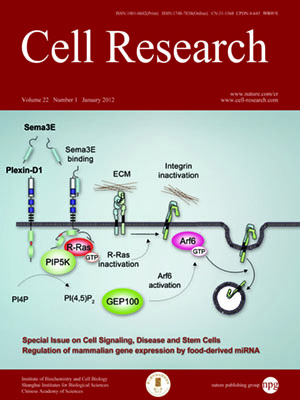
Volume 22, No 1, Jan 2012
ISSN: 1001-0602
EISSN: 1748-7838 2018
impact factor 17.848*
(Clarivate Analytics, 2019)
Volume 22 Issue 1, January 2012: 208-218
ORIGINAL ARTICLES
Direct reprogramming of sertoli cells into multipotent neural stem cells by defined factors
Chao Sheng1,2,*, Qinyuan Zheng1,6,*, Jianyu Wu3,*, Zhen Xu4,6, Libin Wang1,6, Wei Li1,6, Haijiang Zhang1, Xiao-Yang Zhao1, Lei Liu1, Ziwei Wang1,6
1State Key Laboratory of Reproductive Biology, Institute of Zoology, Chinese Academy of Sciences, Beijing 100101, China
2College of Life Science, Northeast Agricultural University of China, Harbin 150030, China
3Center for Regenerative Medicine, Beijing Institute of Geriatrics, Xuanwu Hospital, Capital Medical University, Beijing, China, and Key Laboratory of Neurodegeneration, Ministry of Education, Beijing 100053, China
4State Key Laboratory of Brain and Cognitive Sciences, Institute of Biophysics, Chinese Academy of Sciences, Beijing 100101, China
5State Key Laboratory of Plant Genomics, Institute of Genetics and Developmental Biology, Chinese Academy of Sciences, Beijing 100101, China
6Graduate School of Chinese Academy of Sciences, Beijing 100049, China
Correspondence: Zhiguo Chen, Qi Zhou,(chenzhiguo@gmail.com; qzhou@ioz.ac.cn)
Multipotent neural stem/progenitor cells hold great promise for cell therapy. The reprogramming of fibroblasts to induced pluripotent stem cells as well as mature neurons suggests a possibility to convert a terminally differentiated somatic cell into a multipotent state without first establishing pluripotency. Here, we demonstrate that sertoli cells derived from mesoderm can be directly converted into a multipotent state that possesses neural stem/progenitor cell properties. The induced neural stem/progenitor cells (iNSCs) express multiple NSC-specific markers, exhibit a global gene-expression profile similar to normal NSCs, and are capable of self-renewal and differentiating into glia and electrophysiologically functional neurons. iNSC-derived neurons stain positive for tyrosine hydroxylase (TH), ?-aminobutyric acid, and choline acetyltransferase. In addition, iNSCs can survive and generate synapses following transplantation into the dentate gyrus. Generation of iNSCs may have important implications for disease modeling and regenerative medicine.
Multipotent neural stem/progenitor cells hold great promise for cell therapy. The reprogramming of fibroblasts to induced pluripotent stem cells as well as mature neurons suggests a possibility to convert a terminally differentiated somatic cell into a mu
FULL TEXT | PDF
Browse 2562


